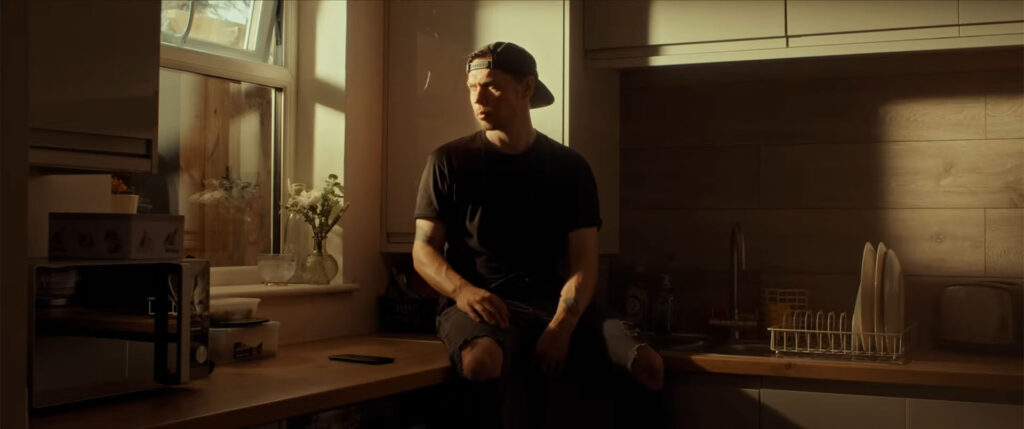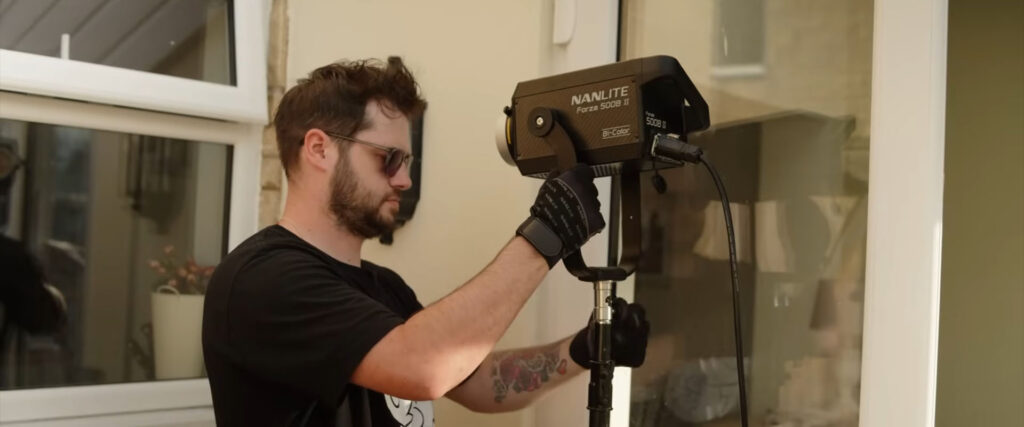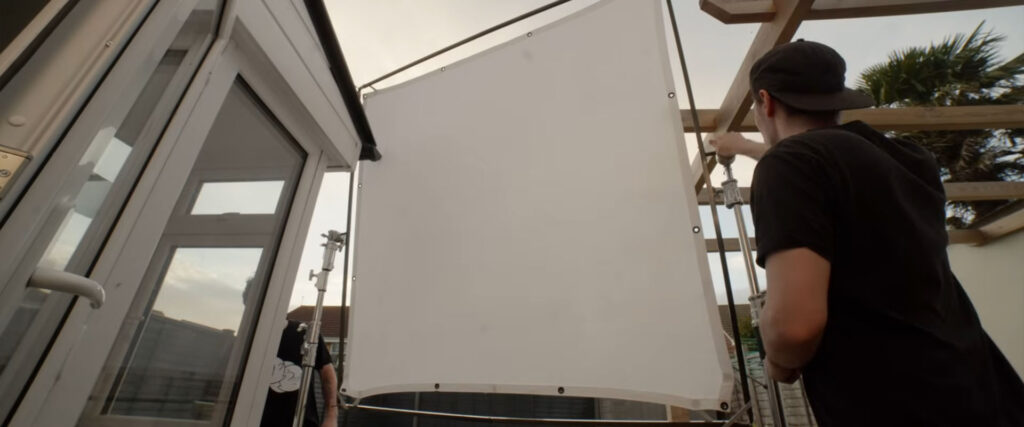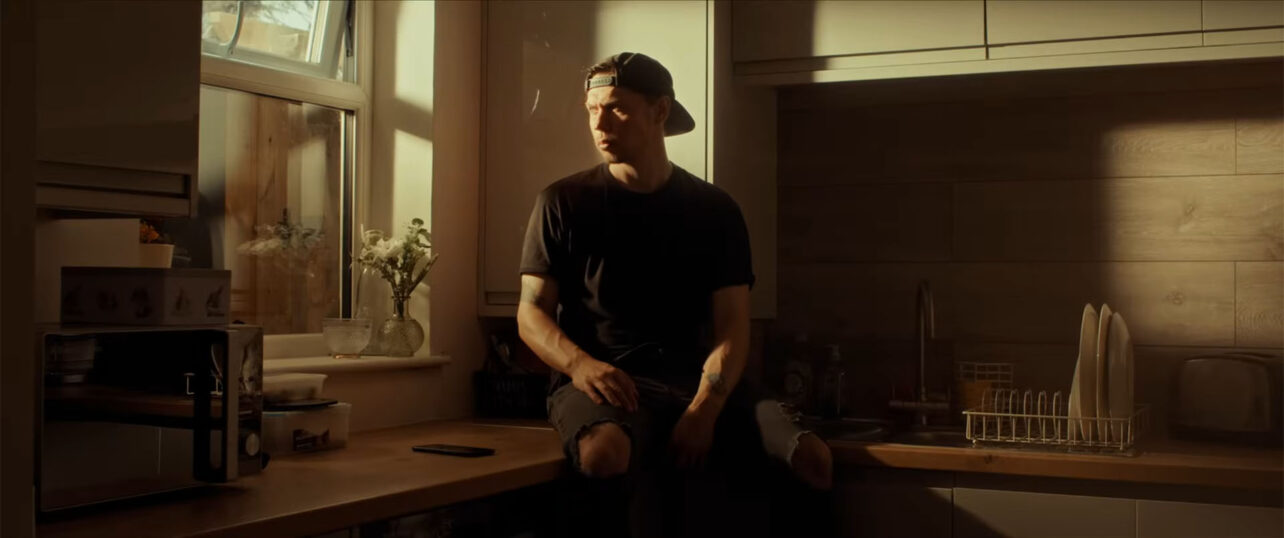In this series, we’ll explore the techniques and tools you can use to develop your own creative voice within the medium of cinematography by improving how you light scenes both realistically and stylistically. This is “Lighting for Cinema A to Z.”
I emplore you to watch the video tutorial for a full visual demonstration, but you can find the written text below for further clarification.
What is Ambient Light?
What’s the difference between these two images? There’s a clear distinction in the way we’ve handled the shadows, and that’s because we’ve either added to or taken away from the ambient light at the location.

Ambient light generally refers to any uncontrolled light that already exists within a scene. For instance, if we shoot in daylight without any control, we can consider all of the natural light exposing our scene as ambient light.

Similarly, if we film on a street at night without control over street or window lights, this too is ambient light.
Shooting in a kitchen during the day, one might assume the room is filled with ambient light. However, even if the scene feels naturally lit, in reality, it’ nighttime, and we have control over every lighting aspect, even replicating the sun.

How To Recreate Ambient Light
We set up our lighting before it got dark. First, we positioned aNanlite Forza 500 B2 outside the window, coupling it with a compatible FL-20g lens to emulate the Sun.

But since we filmed after sunset, there’s minimal ambient light inside. Without skylight permeating our location’s windows, shadows prevail. Although the walls reflect some light from our artificial sunlight, achieving the ambiance of a sunny daytime shot proves challenging.
One might wonder how to increase the ambient illumination in such a case. If ambient light is by definition uncontrolled, how can we alter it without contradicting its nature? When enhancing ambience with our lights, we aim to replicate the essence of uncontrolled light. In daylight conditions, this typically means employing a large, soft fill light. With existing ambient light, the solution might be as simple as reflecting a light onto the ceiling to augment what’s already present. If starting from scratch, creating realistic light necessitates careful layering.

A practical initial step is to simulate the sky. We assembled a 4×4 frame, secured it to two stands, and hoisted it above the window. Beneath, we positioned a Forza 720b, equipped with a 55-degree reflector dish, directing it towards our frame’s white side. This mimics the sky, introducing a soft glow into the kitchen and mitigating some shadowy areas. Naturally, daylight doesn’t solely originate from above the window; it scatters from various angles and other outdoor objects also reflect light indoors. To emulate this, we used a larger 6×6 frame made of bleached muslin opposite the window, and projected a nanlux 1200 B with a 60-degree reflector dish onto it. This procedure might seem incremental, but each step intensifies the ambient effect. The reflected light isn’t just directional—it radiates from multiple windows, reflects off walls and ceilings, subtly illuminating shadows similarly to genuine ambient light.

Considering how actual daylight impacts a location offers more solutions. A modest Forza 60c with a 45-degree reflector, reflected off the ceiling, could simulate sunlight. Given that sunlight can reflect off windows, vehicles, or household items, introducing a ceiling bounce light is a realistic addition to this daytime setup.

As the scene takes shape, we can refine it further. A cool-toned Forza 60c can accentuate the wall’s existing reflected light, enhancing its realism by simulating the cooler sky’s potential influence. To complete the scene, we inserted a window section from an earlier shoot during daylight, underscoring the effectiveness of meticulous light layering in evoking the sensation of uncontrolled ambient light.
However, because we command this lighting, we can also adjust or remove components to achieve a desired mood. To truly appreciate the value of ambient, removing just our primary sunlight source reveals how foundational ambient daylight is in naturally filling shadows. For those keen on mastering daylight replication, I recommend my course on shopmoment.com. It delves into daylight’s natural qualities and hues, illustrating that understanding these facets empowers you to intentionally light a scene.
In the upcoming part two, we’ll discuss controlling and diminishing ambient light to both sculpt the image and infuse your scene with mood.
In conclusion, if you’re looking to hone your lighting skills, especially in replicating natural light, I’d recommend checking out my latest course, “Recreating Daylight,” available now on Shop Moment. For those passionate about color grading, Dehancer is an invaluable tool, and you can benefit from a 10% discount using the code “ROBELLIS” at checkout. Lastly, for extended, ad-free content including my “Lighting with Colour” mini course, consider supporting my work on Patreon. Your support helps in delivering in-depth tutorials and early access to content.
For more on cinematography, check out the articles below


